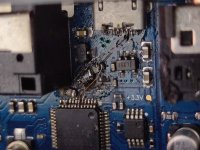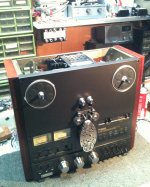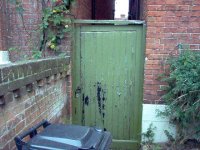Let's see, a bad cap in a Pioneer? No way!
I would be very surprised if that was the only bad or iffy cap in there. They used terribly cheap parts.
I would be very surprised if that was the only bad or iffy cap in there. They used terribly cheap parts.
An ASR Emitter with blown channel, and controller section not working.
Water damage in my oldest sound basement, was a lot of work…
Intermittent channel amp into my home theatre Anthem 5 channels amp
Arcam CD23, no audio output, just digital, one cap blown into one of the supplies
Water damage in my oldest sound basement, was a lot of work…
Intermittent channel amp into my home theatre Anthem 5 channels amp
Arcam CD23, no audio output, just digital, one cap blown into one of the supplies
I dead bug style restored functionality of a burned down USB input in an SMSL Q5 Pro mini desktop amplifier. A black hole in the PCB was all it remained of the 0402 size SMD components comprising the input route of the TAS1020B receiver chip. No pads remained to solder on and vias were blown around & further upstream. After much patience with a dirt cheap headband magnifier and fine tweezers it was recognized by the PC, locked, and playing again without interruptions or noises.
For a sense of scale, the copper strands you see for point to point connections are teared out "hair" from solder wick braid.
BTW that's not a solder bridge on two pins of the TQFP package, its intentional to restore a common ground return blown.
For a sense of scale, the copper strands you see for point to point connections are teared out "hair" from solder wick braid.
BTW that's not a solder bridge on two pins of the TQFP package, its intentional to restore a common ground return blown.
Attachments
Impressive man. That scale is way to small for me - I wouldn't have had the patience or dexterity to do that repair. That's why I deal with through hole parts 😀
I also hate dealing with parts I can not see, but I gave it a try because challenging. Tiring stuff. It takes a dedicated stereo microscope to consider doing this any often.
I've often joked to customers that in fact, what I do is sometimes more complex than just traditional electronic repairing.
I use the term "brain surgeon".
However, I tend to avoid SMD stuff if possible, it's nerve wracking.
I'll sometimes do repairs on burned traces though.
I use the term "brain surgeon".
However, I tend to avoid SMD stuff if possible, it's nerve wracking.
I'll sometimes do repairs on burned traces though.
Ya, the odd 8-SOIC or those little 0402 style parts aren't bad once in a while but anything more than that can be someone else's repair...
Salas, great work. You have patience for sure.
I would not have repaired it. Life is too short for that stuff.
I would not have repaired it. Life is too short for that stuff.
I've often joked to customers that in fact, what I do is sometimes more complex than just traditional electronic repairing.
I use the term "brain surgeon".
However, I tend to avoid SMD stuff if possible, it's nerve wracking.
I'll sometimes do repairs on burned traces though.
I actually find SMD stuff to be less annoying than trying to desolder through-hole parts on a board with plated through-holes. I mean, sure, BGA packages and 0402 resistors aren't real fun to deal with, but SOIC, SOT-23 and 1206 / 0805 packages aren't bad at all with a tweezers and the right tip.
I don't even know if I am gonna try and repair this -- a NAD T755 with a blown channel. All microprocessor controlled. The service manual is 94 pages!
I actually find SMD stuff to be less annoying than trying to desolder through-hole parts on a board with plated through-holes. I mean, sure, BGA packages and 0402 resistors aren't real fun to deal with, but SOIC, SOT-23 and 1206 / 0805 packages aren't bad at all with a tweezers and the right tip.
Well, good for you, you can have all the SMD work you want.😀
Go for it baby!
That system of component design was designed for the "throw-away" era, where you simply replace the whole board after paying the supplier an enormous bit of money for a replacement.
It's part of the "greed" scandal ya know.
Big Tech intended to put us "small guys" out of business, and many unfortunately succumbed to it.
And at times I've had to pass that higher cost off to the customer, naturally.
Same goes for those IC chips with rubbed-off identifications and/or lack of service schematic so you can't determine a replacement.
It's forced us in the service industry to lose out, and turn down repairs/revenue.
When you work in a busy repair shop, you don't have the luxury of putzing around trying to research things like that, time is money.
I don't even know if I am gonna try and repair this -- a NAD T755 with a blown channel. All microprocessor controlled. The service manual is 94 pages!
Only 94 pages?
Last year I had to overhaul a Technics RS-1500US reel-to-reel deck from top to bottom.
The TWO needed service manuals a total of 113 pages to plow through.
Talk about FUN! 😱
Attachments
That system of component design was designed for the "throw-away" era, where you simply replace the whole board after paying the supplier an enormous bit of money for a replacement.
It's part of the "greed" scandal ya know.
It's kind of true. In my case, it's not greed. I actually barely charge more than cost for my stuff. I designed the MA-1 in such a way that if you need to replace a socket, you can just change the board for less than the labour cost. And it's faster. 10 minute downtime if you have the spare board already.
I have agreed with that, since say the mid 80's when I learnt some smt while at Motorola. Next amp design will have a smt front end. Very few assemblies are 100% smt, most are mixed tech, smt and few tht.I actually find SMD stuff to be less annoying than trying to desolder through-hole parts on a board with plated through-holes. I mean, sure, BGA packages and 0402 resistors aren't real fun to deal with, but SOIC, SOT-23 and 1206 / 0805 packages aren't bad at all with a tweezers and the right tip.
It's funny how you can still get more types of ecaps in tht vs smt, never figured out why. Ones like these Nichicon types, UKL,UPW, UKA, UES etc. I am guessing for higher power assemblies which usually are more tht vs smt.
I finally changed the 2x40 LCD display in the HP 8904A function generator The Amber 358 frequency counter died, I have a spare, but I am looking for the schematic, it is a bunch of ALS logic and a ICL7226A counter chip. Of course I swapped the counter chip and checked the supplies, not so lucky 🙂 Trying to avoid doing the reverse EE if I can. At least I have a working one to compare too. Enough for now
I was busy today with Winter jobs. Garden has gone to sleep.
Maintenance is often better than repair IMO. "A stitch in Time" and all that. 🙂
Painted the Garden Door with Ronseal One-coat Timber Care. Tricky bit was opening the container. No instructions. 😕
Took ages actually, and I specially paid attention to the bottom, which is where the ROT often sets in IMO. As you can see.
The second picture is of my foolish neighbour Paul's neglected Garden Door.
Take more than a coat of Paint to fix THAT! 😀
Maintenance is often better than repair IMO. "A stitch in Time" and all that. 🙂
Painted the Garden Door with Ronseal One-coat Timber Care. Tricky bit was opening the container. No instructions. 😕
Took ages actually, and I specially paid attention to the bottom, which is where the ROT often sets in IMO. As you can see.
The second picture is of my foolish neighbour Paul's neglected Garden Door.
Take more than a coat of Paint to fix THAT! 😀
Attachments
- Home
- Member Areas
- The Lounge
- What did you last repair?




